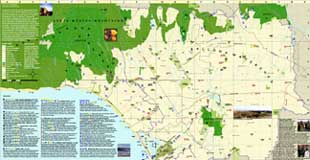 |
|||||||||||||||||||||||||||||||||||||||||||||||||||||
| |
The Ballona Watershed Green Map displays ecological and cultural resources found throughout the Ballona Watershed, such as important waterways, wildlife migration routes, wetlands, public lands, alternative transportation corridors, environmental organizations and green businesses. WHAT IS A
WATERSHED? A watershed
is an area of land that drains all rain that falls within it to
a common point. This map identifies environmental features and resources
in the Ballona Watershed, which is part of the larger Santa Monica
Bay watershed. The Ballona Watershed drains through Ballona Creek
to Santa Monica Bay. The Ballona
Watershed Green Map shows the entire watershed of La Ballona Creek,
including the communities of Santa Monica, Culver City, Beverly
Hills, Inglewood, West Hollywood, Venice, West Los Angeles, and
Los Angeles and the natural features that run throughout the watershed.
These features include:
Home
> Kid's Santa
Monica Pier Green Map > Ballona Watershed > Santa
Monica > Los Angeles County Open Space
Maps > About Us
> Press |
||||||||||||||||||||||||||||||||||||||||||||||||||||
